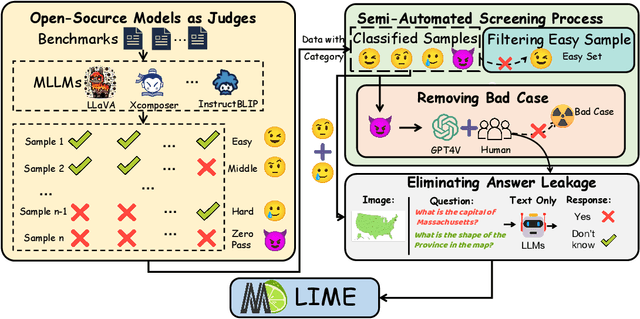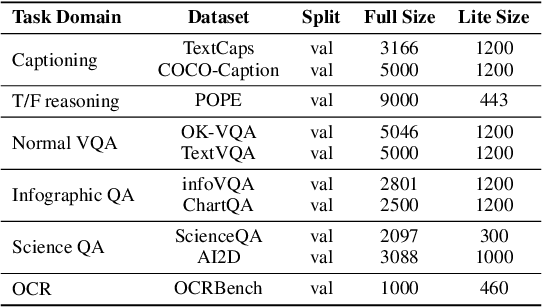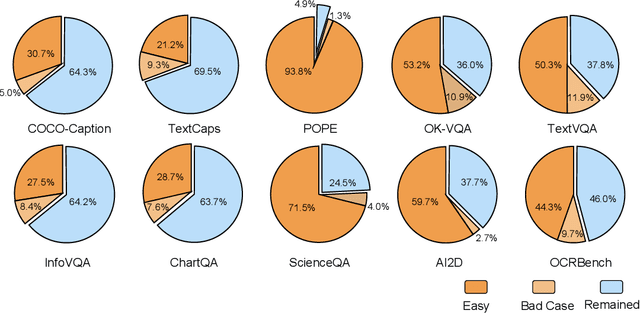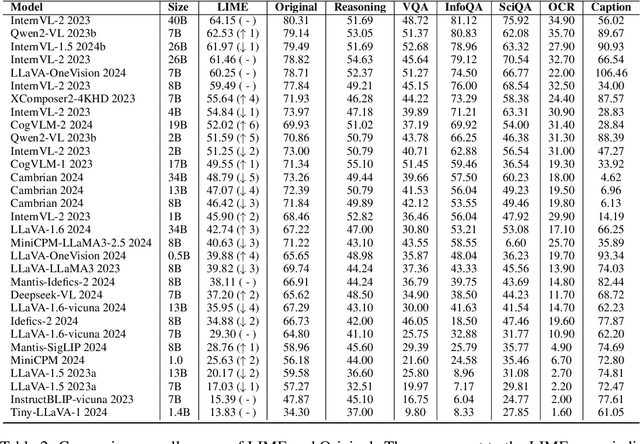Siwei Wu
Scaling Test-time Compute for LLM Agents
Jun 15, 2025Abstract:Scaling test time compute has shown remarkable success in improving the reasoning abilities of large language models (LLMs). In this work, we conduct the first systematic exploration of applying test-time scaling methods to language agents and investigate the extent to which it improves their effectiveness. Specifically, we explore different test-time scaling strategies, including: (1) parallel sampling algorithms; (2) sequential revision strategies; (3) verifiers and merging methods; (4)strategies for diversifying rollouts.We carefully analyze and ablate the impact of different design strategies on applying test-time scaling on language agents, and have follow findings: 1. Scaling test time compute could improve the performance of agents. 2. Knowing when to reflect is important for agents. 3. Among different verification and result merging approaches, the list-wise method performs best. 4. Increasing diversified rollouts exerts a positive effect on the agent's task performance.
DocMMIR: A Framework for Document Multi-modal Information Retrieval
May 25, 2025Abstract:The rapid advancement of unsupervised representation learning and large-scale pre-trained vision-language models has significantly improved cross-modal retrieval tasks. However, existing multi-modal information retrieval (MMIR) studies lack a comprehensive exploration of document-level retrieval and suffer from the absence of cross-domain datasets at this granularity. To address this limitation, we introduce DocMMIR, a novel multi-modal document retrieval framework designed explicitly to unify diverse document formats and domains, including Wikipedia articles, scientific papers (arXiv), and presentation slides, within a comprehensive retrieval scenario. We construct a large-scale cross-domain multimodal benchmark, comprising 450K samples, which systematically integrates textual and visual information. Our comprehensive experimental analysis reveals substantial limitations in current state-of-the-art MLLMs (CLIP, BLIP2, SigLIP-2, ALIGN) when applied to our tasks, with only CLIP demonstrating reasonable zero-shot performance. Furthermore, we conduct a systematic investigation of training strategies, including cross-modal fusion methods and loss functions, and develop a tailored approach to train CLIP on our benchmark. This results in a +31% improvement in MRR@10 compared to the zero-shot baseline. All our data and code are released in https://github.com/J1mL1/DocMMIR.
DeepMath-Creative: A Benchmark for Evaluating Mathematical Creativity of Large Language Models
May 13, 2025

Abstract:To advance the mathematical proficiency of large language models (LLMs), the DeepMath team has launched an open-source initiative aimed at developing an open mathematical LLM and systematically evaluating its mathematical creativity. This paper represents the initial contribution of this initiative. While recent developments in mathematical LLMs have predominantly emphasized reasoning skills, as evidenced by benchmarks on elementary to undergraduate-level mathematical tasks, the creative capabilities of these models have received comparatively little attention, and evaluation datasets remain scarce. To address this gap, we propose an evaluation criteria for mathematical creativity and introduce DeepMath-Creative, a novel, high-quality benchmark comprising constructive problems across algebra, geometry, analysis, and other domains. We conduct a systematic evaluation of mainstream LLMs' creative problem-solving abilities using this dataset. Experimental results show that even under lenient scoring criteria -- emphasizing core solution components and disregarding minor inaccuracies, such as small logical gaps, incomplete justifications, or redundant explanations -- the best-performing model, O3 Mini, achieves merely 70% accuracy, primarily on basic undergraduate-level constructive tasks. Performance declines sharply on more complex problems, with models failing to provide substantive strategies for open problems. These findings suggest that, although current LLMs display a degree of constructive proficiency on familiar and lower-difficulty problems, such performance is likely attributable to the recombination of memorized patterns rather than authentic creative insight or novel synthesis.
COIG-P: A High-Quality and Large-Scale Chinese Preference Dataset for Alignment with Human Values
Apr 07, 2025Abstract:Aligning large language models (LLMs) with human preferences has achieved remarkable success. However, existing Chinese preference datasets are limited by small scale, narrow domain coverage, and lack of rigorous data validation. Additionally, the reliance on human annotators for instruction and response labeling significantly constrains the scalability of human preference datasets. To address these challenges, we design an LLM-based Chinese preference dataset annotation pipeline with no human intervention. Specifically, we crawled and carefully filtered 92k high-quality Chinese queries and employed 15 mainstream LLMs to generate and score chosen-rejected response pairs. Based on it, we introduce COIG-P (Chinese Open Instruction Generalist - Preference), a high-quality, large-scale Chinese preference dataset, comprises 1,009k Chinese preference pairs spanning 6 diverse domains: Chat, Code, Math, Logic, Novel, and Role. Building upon COIG-P, to reduce the overhead of using LLMs for scoring, we trained a 8B-sized Chinese Reward Model (CRM) and meticulously constructed a Chinese Reward Benchmark (CRBench). Evaluation results based on AlignBench \citep{liu2024alignbenchbenchmarkingchinesealignment} show that that COIG-P significantly outperforms other Chinese preference datasets, and it brings significant performance improvements ranging from 2% to 12% for the Qwen2/2.5 and Infinity-Instruct-3M-0625 model series, respectively. The results on CRBench demonstrate that our CRM has a strong and robust scoring ability. We apply it to filter chosen-rejected response pairs in a test split of COIG-P, and our experiments show that it is comparable to GPT-4o in identifying low-quality samples while maintaining efficiency and cost-effectiveness. Our codes and data are released in https://github.com/multimodal-art-projection/COIG-P.
ContrastScore: Towards Higher Quality, Less Biased, More Efficient Evaluation Metrics with Contrastive Evaluation
Apr 02, 2025Abstract:Evaluating the quality of generated text automatically remains a significant challenge. Conventional reference-based metrics have been shown to exhibit relatively weak correlation with human evaluations. Recent research advocates the use of large language models (LLMs) as source-based metrics for natural language generation (NLG) assessment. While promising, LLM-based metrics, particularly those using smaller models, still fall short in aligning with human judgments. In this work, we introduce ContrastScore, a contrastive evaluation metric designed to enable higher-quality, less biased, and more efficient assessment of generated text. We evaluate ContrastScore on two NLG tasks: machine translation and summarization. Experimental results show that ContrastScore consistently achieves stronger correlation with human judgments than both single-model and ensemble-based baselines. Notably, ContrastScore based on Qwen 3B and 0.5B even outperforms Qwen 7B, despite having only half as many parameters, demonstrating its efficiency. Furthermore, it effectively mitigates common evaluation biases such as length and likelihood preferences, resulting in more robust automatic evaluation.
LongEval: A Comprehensive Analysis of Long-Text Generation Through a Plan-based Paradigm
Feb 26, 2025Abstract:Large Language Models (LLMs) have achieved remarkable success in various natural language processing tasks, yet their ability to generate long-form content remains poorly understood and evaluated. Our analysis reveals that current LLMs struggle with length requirements and information density in long-text generation, with performance deteriorating as text length increases. To quantitively locate such a performance degradation and provide further insights on model development, we present LongEval, a benchmark that evaluates long-text generation through both direct and plan-based generation paradigms, inspired by cognitive and linguistic writing models. The comprehensive experiments in this work reveal interesting findings such as that while model size correlates with generation ability, the small-scale model (e.g., LongWriter), well-trained on long texts, has comparable performance. All code and datasets are released in https://github.com/Wusiwei0410/LongEval.
SuperGPQA: Scaling LLM Evaluation across 285 Graduate Disciplines
Feb 20, 2025Abstract:Large language models (LLMs) have demonstrated remarkable proficiency in mainstream academic disciplines such as mathematics, physics, and computer science. However, human knowledge encompasses over 200 specialized disciplines, far exceeding the scope of existing benchmarks. The capabilities of LLMs in many of these specialized fields-particularly in light industry, agriculture, and service-oriented disciplines-remain inadequately evaluated. To address this gap, we present SuperGPQA, a comprehensive benchmark that evaluates graduate-level knowledge and reasoning capabilities across 285 disciplines. Our benchmark employs a novel Human-LLM collaborative filtering mechanism to eliminate trivial or ambiguous questions through iterative refinement based on both LLM responses and expert feedback. Our experimental results reveal significant room for improvement in the performance of current state-of-the-art LLMs across diverse knowledge domains (e.g., the reasoning-focused model DeepSeek-R1 achieved the highest accuracy of 61.82% on SuperGPQA), highlighting the considerable gap between current model capabilities and artificial general intelligence. Additionally, we present comprehensive insights from our management of a large-scale annotation process, involving over 80 expert annotators and an interactive Human-LLM collaborative system, offering valuable methodological guidance for future research initiatives of comparable scope.
A Comparative Study on Reasoning Patterns of OpenAI's o1 Model
Oct 17, 2024



Abstract:Enabling Large Language Models (LLMs) to handle a wider range of complex tasks (e.g., coding, math) has drawn great attention from many researchers. As LLMs continue to evolve, merely increasing the number of model parameters yields diminishing performance improvements and heavy computational costs. Recently, OpenAI's o1 model has shown that inference strategies (i.e., Test-time Compute methods) can also significantly enhance the reasoning capabilities of LLMs. However, the mechanisms behind these methods are still unexplored. In our work, to investigate the reasoning patterns of o1, we compare o1 with existing Test-time Compute methods (BoN, Step-wise BoN, Agent Workflow, and Self-Refine) by using OpenAI's GPT-4o as a backbone on general reasoning benchmarks in three domains (i.e., math, coding, commonsense reasoning). Specifically, first, our experiments show that the o1 model has achieved the best performance on most datasets. Second, as for the methods of searching diverse responses (e.g., BoN), we find the reward models' capability and the search space both limit the upper boundary of these methods. Third, as for the methods that break the problem into many sub-problems, the Agent Workflow has achieved better performance than Step-wise BoN due to the domain-specific system prompt for planning better reasoning processes. Fourth, it is worth mentioning that we have summarized six reasoning patterns of o1, and provided a detailed analysis on several reasoning benchmarks.
SongTrans: An unified song transcription and alignment method for lyrics and notes
Sep 22, 2024



Abstract:The quantity of processed data is crucial for advancing the field of singing voice synthesis. While there are tools available for lyric or note transcription tasks, they all need pre-processed data which is relatively time-consuming (e.g., vocal and accompaniment separation). Besides, most of these tools are designed to address a single task and struggle with aligning lyrics and notes (i.e., identifying the corresponding notes of each word in lyrics). To address those challenges, we first design a pipeline by optimizing existing tools and annotating numerous lyric-note pairs of songs. Then, based on the annotated data, we train a unified SongTrans model that can directly transcribe lyrics and notes while aligning them simultaneously, without requiring pre-processing songs. Our SongTrans model consists of two modules: (1) the \textbf{Autoregressive module} predicts the lyrics, along with the duration and note number corresponding to each word in a lyric. (2) the \textbf{Non-autoregressive module} predicts the pitch and duration of the notes. Our experiments demonstrate that SongTrans achieves state-of-the-art (SOTA) results in both lyric and note transcription tasks. Furthermore, it is the first model capable of aligning lyrics with notes. Experimental results demonstrate that the SongTrans model can effectively adapt to different types of songs (e.g., songs with accompaniment), showcasing its versatility for real-world applications.
LIME-M: Less Is More for Evaluation of MLLMs
Sep 10, 2024



Abstract:With the remarkable success achieved by Multimodal Large Language Models (MLLMs), numerous benchmarks have been designed to assess MLLMs' ability to guide their development in image perception tasks (e.g., image captioning and visual question answering). However, the existence of numerous benchmarks results in a substantial computational burden when evaluating model performance across all of them. Moreover, these benchmarks contain many overly simple problems or challenging samples, which do not effectively differentiate the capabilities among various MLLMs. To address these challenges, we propose a pipeline to process the existing benchmarks, which consists of two modules: (1) Semi-Automated Screening Process and (2) Eliminating Answer Leakage. The Semi-Automated Screening Process filters out samples that cannot distinguish the model's capabilities by synthesizing various MLLMs and manually evaluating them. The Eliminate Answer Leakage module filters samples whose answers can be inferred without images. Finally, we curate the LIME-M: Less Is More for Evaluation of Multimodal LLMs, a lightweight Multimodal benchmark that can more effectively evaluate the performance of different models. Our experiments demonstrate that: LIME-M can better distinguish the performance of different MLLMs with fewer samples (24% of the original) and reduced time (23% of the original); LIME-M eliminates answer leakage, focusing mainly on the information within images; The current automatic metric (i.e., CIDEr) is insufficient for evaluating MLLMs' capabilities in captioning. Moreover, removing the caption task score when calculating the overall score provides a more accurate reflection of model performance differences. All our codes and data are released at https://github.com/kangreen0210/LIME-M.
 Add to Chrome
Add to Chrome Add to Firefox
Add to Firefox Add to Edge
Add to Edge